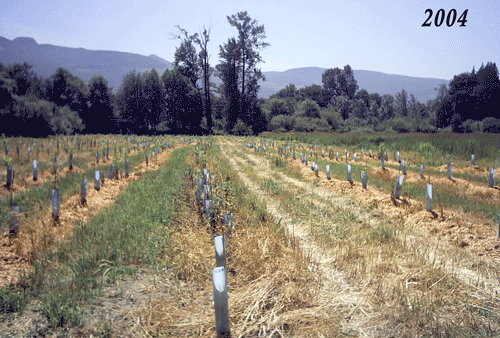
Conservation Reserve Enhancement Program
CREP pays the expenses to establish the buffer
CREP is a voluntary program that pays landowners to establish forested buffers along streams where riparian habitat is a significant limiting factor for salmon. In addition to providing fish and wildlife habitat, buffers of native vegetation help protect water quality, stabilize stream banks, reduce erosion, lower water temperatures, and provide attractive borders for privacy and protection.
The Basics
-
Land enrolled is removed from production under a 10 to 15 year rental contract.
-
Landowners are reimbursed 100% of the costs.
-
Buffer design ranges from 50-180ft.
-
Owner receives annual payments.
-
Technical assistance provided to design, install, and maintain buffer.
Eligibility
-
Land must be adjacent to a salmon-bearing stream.
-
Land must not be currently functioning as a forested riparian buffer as determined by the SCD technician.
-
Land must be able to support native trees and shrubs.
Next Steps
-
A Resource Specialist will complete a site assessment of the property.
-
Discuss options and receive estimated rental rate.
-
Land must be able to support native trees and shrubs.



Links
-
Look up your soil type with this interactive Web Soil Survey mapper provided by the Natural Resources Conservation Service.
-
Effectiveness Monitoring Report on CREP by Washington State Conservation Commission.
-
United States Department of Agriculture Farm Service Agency - CREP

Salmon Recovery Funding
In 2022, the Washington Legislature appropriated $10 million in funding to be used in incentive-based funding to help with salmon recovery projects. The Salmon Recovery Funding (SRF) Program encourages incentive programs with landowners that focus on the restoration of critical areas in salmon habitat, otherwise known as riparian restoration projects. Since July, 11 projects have been awarded funding within Skagit Conservation District, encompassing 15,755 linear feet of stream (3 miles) and 8,620 native trees/shrubs!
We partnered with the Skagit Watershed Council and WSCC to learn more about landowner perceptions of riparian plantings and programs that can help fund this work. Some barrier’s landowners reported included arduous cost-share application processes and insufficient compensation to do this work, as well as the planting width requirements in some programs.
Other CD's have developed cash incentive programs that help offset lost revenue when farmers plant perennial species along waterways where they previously cropped. Skagit CD decided to develop a cash incentive program, similar to CREP. Our new program is available to a wide variety of stream-side properties. Eligible projects can receive a one-time payment equal to 5 times the CREP soil rental rate, as well as a 20% bonus payment when a planting exceeds 100 feet in width, or a 40% bonus for projects that meet the WDFW site potential tree height chart for your soil type. Of the 11 projects funded through the Salmon Recovery Program, 3 are receiving cash incentives.
The WSCC program guidelines allow for four types of projects to be funded with this allocation.
-
Landowner Implemented Cost Shate Projects (Like the majority of SCD projects)
-
District Implemented Projects (Often large-scale or complex projects involving permitting and interagency coordination)
-
Project Planning and Design (This allows for project design and permitting costs to be covered in preparation for construction in the future.)
-
Incentives Programs (Eligible projects can receive a one-time payment when a planting exceeds 100 ft. in width, or a 40% bonus for projects that meet the WDFW site potential tree height chart for your area.
